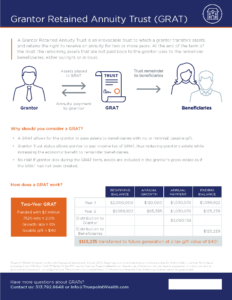Understanding Grantor Retained Annuity Trusts (GRAT)

With the federal estate tax exemptions set to decrease from $11.58 million (adjusted for inflation each year) to $5 million (adjusted for inflation), over the next several years, individuals with a net worth exceeding $5 million should be seeking strategies to reduce or minimize the impact of the federal estate tax should they pass after 2026. One strategy to pass appreciating assets down to future generations is a Grantor Retained Annuity Trust (“GRAT”).
A Grantor Retained Annuity Trust is an irrevocable trusts that works as follows:
- The person who creates the GRAT (the “Grantor”) transfers appreciating assets, such as P&G stock, to the GRAT.
- The terms of the GRAT require that the grantor receive an annuity back for a period of time. The annuity is based on the value of the appreciating assets funding the GRAT plus expected interest based on the IRS 7520 rate, which varies from month to month.
- After all annuity payments are made, if the value of the appreciating assets plus income earned by the assets exceeds the originally calculated annuity payments, the remainder passes to the remaining beneficiaries, estate and gift tax free.
Thus, individuals and families who have assets equal to or exceeding the applicable estate tax exemption thresholds should consider a Grantor Retained Annuity Trust as a way to pass assets to future generations without exhausting large amounts of estate and gift tax exemption that may be applied to other assets or strategies.




